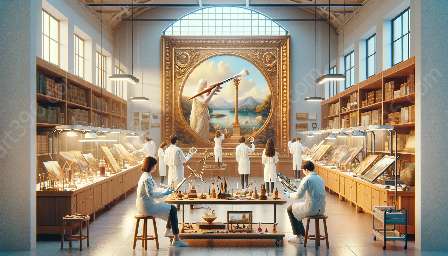Outdoor and public art installations play an important role in shaping the cultural landscape of a community and are often cherished for their aesthetic, cultural, and historical significance. However, these artworks face unique challenges when it comes to preventive conservation, as they are subjected to environmental elements, vandalism, and the need for ongoing maintenance.
Environmental Factors: One of the primary challenges in the preventive conservation of outdoor and public art installations is the impact of environmental factors. These artworks are exposed to harsh weather conditions, such as extreme temperatures, moisture, sunlight, and air pollution, which can lead to deterioration and damage over time. The preservation of outdoor art requires careful consideration of these environmental elements and the development of strategies to mitigate their effects.
Vandalism: Another significant challenge in the conservation of outdoor and public art is the risk of vandalism. Unfortunately, these artworks are often vulnerable to intentional damage, graffiti, or theft. Preventive conservation efforts must include security measures and community engagement to protect these cultural assets from acts of vandalism and ensure their long-term preservation.
Maintenance: The ongoing maintenance of outdoor and public art installations is essential for their preservation. Regular inspections, cleaning, and repair work are necessary to address wear and tear, structural issues, and any damage caused by environmental factors or vandalism. Conservation professionals work closely with artists, stakeholders, and local authorities to establish comprehensive maintenance plans that ensure the longevity of these artworks.
Art Conservation Techniques for Outdoor and Public Art Installations
Art conservation techniques are instrumental in addressing the challenges associated with preventive conservation in outdoor and public art installations. Conservation specialists utilize a range of approaches to safeguard these artworks and ensure their continued existence for future generations.
Surface Protection: Protective coatings, such as clear sealants and specialized paints, can be applied to outdoor art installations to create a barrier against environmental pollutants, UV radiation, and moisture. These surface treatments help minimize the impact of external factors and reduce the risk of deterioration.
Monitoring and Documentation: Conservation professionals implement comprehensive monitoring and documentation processes to track the condition of outdoor and public art over time. This includes regular assessments, digital imaging, and the use of environmental monitoring equipment to evaluate any changes or damage to the artworks.
Community Engagement: Engaging with the local community is vital for the preventive conservation of outdoor art installations. Building awareness, fostering a sense of ownership, and involving the public in the care and protection of these artworks can lead to a more sustainable approach to conservation and help deter vandalism.
Conservation Treatments: When deterioration or damage occurs, conservation treatments are employed to address specific issues. These treatments may include cleaning, consolidation of materials, structural reinforcement, and the application of protective coatings to restore the integrity and appearance of the artworks.
Conclusion
Preventive conservation in outdoor and public art installations presents a complex set of challenges, but with the application of art conservation techniques and collaborative efforts, these cherished cultural assets can be effectively preserved. By understanding and addressing environmental factors, tackling vandalism, and implementing ongoing maintenance, the longevity and significance of outdoor and public art can be safeguarded for the enjoyment and enrichment of future generations.

